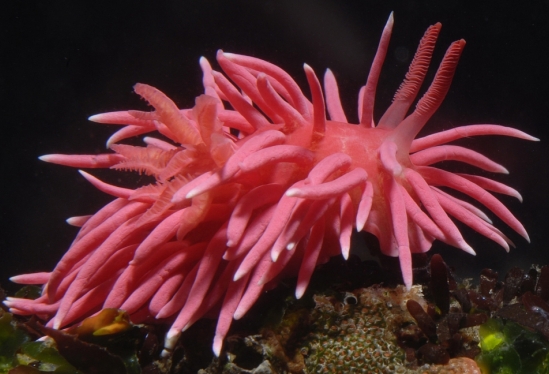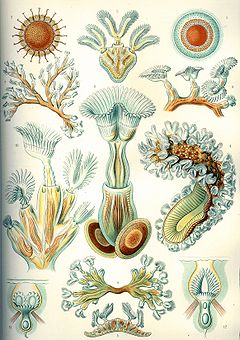Sea Slugs as El Niño Forecasters?

A bright pink sea slug, one inch long, might be the bellweather of approaching El Niños, speculates Jeff Goddard, an invertebrate zoologist with the Marine Science Institute at UCSB. Warmer December waters — up a couple degrees Celsius from the tip of Baja to Alaska — have allowed the nudibranchs to thrive this season, but the heat hasn’t persisted long enough to create classic El Niño conditions, explains Eric Boldt with the National Weather Service (NWS). The NWS has forecasted only a 50-60 percent likelihood of El Niño influencing what’s left of the season.

Hopkins’ rose nudibranchs , as the sea slugs are known, travel as larvae at the whim of warm ocean currents, floating to the bottom as they grow during their first couple months. There they feed exclusively on a pink-colored bryozoan — a diminutive aquatic organism known as a “moss animal” that clusters in colonies — which grows all the way up to British Columbia and imparts the Okenia rosacea‘s remarkable color. Goddard knew that spotting the nudibranchs in high numbers near Morro Bay in mid-January was significant, since they usually hunt down in Southern California. They reminded him of the flourishing pink populations he’d seen near Santa Cruz during 1977’s weak El Niño.
After Morro, Goddard headed up to Monterey to check the tidepools. Along with reports from researchers at UC Santa Cruz, the Bodega Marine Laboratory, and San Francisco’s California Academy of Sciences, his hypothesis was confirmed: The little creatures were everywhere, as far north as Humboldt — sometimes by the dozens per square meter.

The rainy conditions drought-stricken California hopes for, and fears, from El Niños occur within a decades-long seasonal pattern known as the “Pacific Decadal Oscillation,” and the 1977 Hopkins’ rose bloom was followed by strong, wet, stormy El Niños in 1983 and 1998. Goddard wonders if that pattern is due to be repeated. Likewise, in a paper published in Limnology and Oceanography in 2011, Goddard and his co-authors predicted, accurately it turns out, that these same phenomena — changes to temperature and ocean currents, as well as the weak upwelling of cold, nutrient-rich water — would bring nudibranchs north of their usual range again.
For the weather forecasters’ part, an El Niño means that surface water temperatures in an area in the middle of the equatorial Pacific have increased a certain amount over three consecutive months. Though the measurements were trending that way over a couple of months, they’ve simmered down recently. This time, Boldt explained, the warmer water came from last year’s high pressure ridge over the Eastern Pacific that blocked the usual storms and high northwest winds that send chilly water upwelling along our coast.
As for the shoals of sea slugs along the seashore, Goddard predicts that a future El Niño could be major and have surprises in store, some of which can already be found at Los Osos at low tide.
[Editor’s Note: This story has been updated.]


